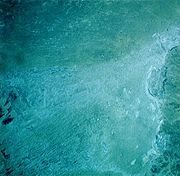
Lake Callabonna
Encyclopedia

Vegetation
Vegetation is a general term for the plant life of a region; it refers to the ground cover provided by plants. It is a general term, without specific reference to particular taxa, life forms, structure, spatial extent, or any other specific botanical or geographic characteristics. It is broader...
in northeastern South Australia
South Australia
South Australia is a state of Australia in the southern central part of the country. It covers some of the most arid parts of the continent; with a total land area of , it is the fourth largest of Australia's six states and two territories.South Australia shares borders with all of the mainland...
, approximately 120 kilometres (74.6 mi) southwest of the junction of South Australia, Queensland and New South Wales at Cameron Corner. It is an important site for late Pleistocene
Pleistocene
The Pleistocene is the epoch from 2,588,000 to 11,700 years BP that spans the world's recent period of repeated glaciations. The name pleistocene is derived from the Greek and ....
fossil
Fossil
Fossils are the preserved remains or traces of animals , plants, and other organisms from the remote past...
s. It forms part of the Strzelecki Desert Lakes Important Bird Area
Strzelecki Desert Lakes Important Bird Area
The Strzelecki Desert Lakes Important Bird Area comprises a series of ephemeral waterbodies in the arid Strzelecki Desert of the Far North region of South Australia...
, identified as such by BirdLife International
BirdLife International
BirdLife International is a global Partnership of conservation organisations that strives to conserve birds, their habitats and global biodiversity, working with people towards sustainability in the use of natural resources...
because of its importance for waterbirds when holding water in the aftermath of floods.
History
The first pastoralists in the area were the Ragless brothers in 1881, who moved there from the northern Flinders RangesFlinders Ranges
Flinders Ranges is the largest mountain range in South Australia, which starts approximately north west of Adelaide. The discontinuous ranges stretch for over from Port Pirie to Lake Callabonna...
, opening a sheep-run. In January 1892 Fred Ragless came across a number of giant skeletons embedded in the dry surface of the lake. An expedition partly funded by Sir Thomas Elder
Thomas Elder
Sir Thomas Elder GCMG was a Scottish-Australian pastoralist, highly successful businessman, philanthropist, politician, race-horse owner and breeder and public figure...
and E. C. Stirling, director of the South Australian Museum
South Australian Museum
The South Australian Museum is a museum in Adelaide, South Australia, founded in 1856. It occupies a complex of buildings on North Terrace in the cultural precinct of the Adelaide Parklands.-History:...
, was organised. After several visits, Stirling and A. H. Zietz collected a large number of diprotodon
Diprotodon
Diprotodon, meaning "two forward teeth", sometimes known as the Giant Wombat or the Rhinoceros Wombat, was the largest known marsupial that ever lived...
and dromornithidae
Dromornithidae
Dromornithidae — the dromornithids — were a family of large, flightless Australian birds of the Oligocene through Pleistocene epochs. All are now extinct. They were long classified in the order Struthioniformes, but are now usually classified as a family of Anseriformes1...
skeletons. The area was designated a Fossil Reserve in 1901, and access is restricted.

